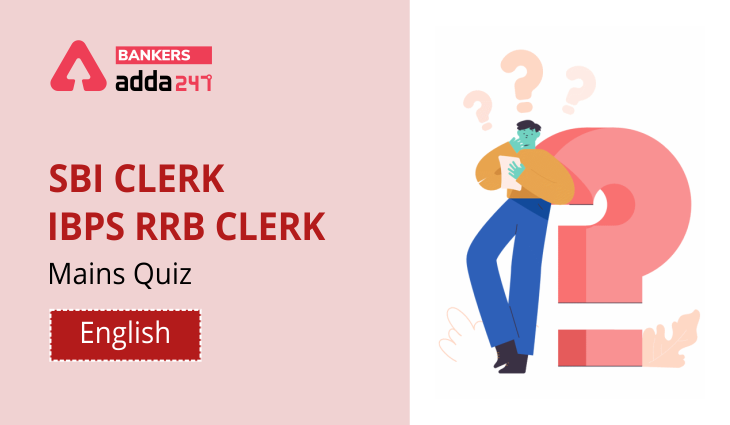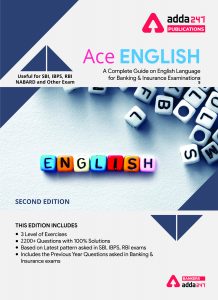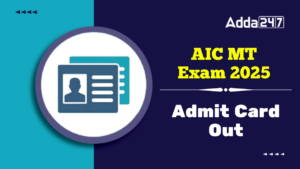Directions (1-5): In the following questions, certain parts of the paragraph are highlighted, which suggest that they may or may not belong to the paragraph. There are five sentences give as options including the highlighted part against each number. Choose the option which suits best into the theme of the paragraph as well as to the contextual meaning of the sentence. If the highlighted portion does not require any replacement, choose option (e) i.e. “No replacement required” as your answer.
Q1. On May 20, 1498, Portuguese explorer Vasco da Gama landed in what is now Kozhikode, India. Da Gama was the first European to reach (1)Indian territory and entered into a partnership with one of the Indian Traders. Portugal and other European empires had been trading with communities in India and throughout Southeast Asia for centuries. The legendary Silk Road was an overland trade route (2)that connected many traders of India with the bustling commerce of the west. However, traveling through disputed territories in the Mediterranean Sea and Arabian Peninsula (3)was meandering and complicated. Da Gama and his fleet used well-traveled routes to navigate down the western coast of Africa. After re-supplying in the Canary Islands, da Gama took a chance and sailed west into the Atlantic Ocean—(4)the direction where he had sailed many times. He took advantage of the strong, reliable winds called Westerlies to quickly steer him to the southern coast of Africa. Da Gama and his fleet rounded the Cape of Good Hope in December 1497, and named the nearby coast Natal, after the Portuguese word for Christmas. (The South African province of KwaZulu-Natal retains this name today.) Da Gama (5)established poor relations with leaders in what are now the coasts of Mozambique and southern Kenya—the Europeans became pirates of Arab trading ships in the region.
(a) sea borders of India by travelling the longest route of the world
(b) spice factory and set up its monopoly there
(c) Indian territory and did lucrative trade there
(d) No correction required
(e) the lucrative trade centers of India by sea
Q2. On May 20, 1498, Portuguese explorer Vasco da Gama landed in what is now Kozhikode, India. Da Gama was the first European to reach (1)Indian territory and entered into a partnership with one of the Indian Traders. Portugal and other European empires had been trading with communities in India and throughout Southeast Asia for centuries. The legendary Silk Road was an overland trade route (2)that connected many traders of India with the bustling commerce of the west. However, traveling through disputed territories in the Mediterranean Sea and Arabian Peninsula (3)was meandering and complicated. Da Gama and his fleet used well-traveled routes to navigate down the western coast of Africa. After re-supplying in the Canary Islands, da Gama took a chance and sailed west into the Atlantic Ocean—(4)the direction where he had sailed many times. He took advantage of the strong, reliable winds called Westerlies to quickly steer him to the southern coast of Africa. Da Gama and his fleet rounded the Cape of Good Hope in December 1497, and named the nearby coast Natal, after the Portuguese word for Christmas. (The South African province of KwaZulu-Natal retains this name today.) Da Gama (5)established poor relations with leaders in what are now the coasts of Mozambique and southern Kenya—the Europeans became pirates of Arab trading ships in the region.
(a) that linked the Portuguese and the Indian traders
(b) that connected the trade centres of India
(c) that linked the fabled spice markets of the east
(d) that opened a spice centr
(e) No correction require
Q3. On May 20, 1498, Portuguese explorer Vasco da Gama landed in what is now Kozhikode, India. Da Gama was the first European to reach (1)Indian territory and entered into a partnership with one of the Indian Traders. Portugal and other European empires had been trading with communities in India and throughout Southeast Asia for centuries. The legendary Silk Road was an overland trade route (2)that connected many traders of India with the bustling commerce of the west. However, traveling through disputed territories in the Mediterranean Sea and Arabian Peninsula (3)was meandering and complicated. Da Gama and his fleet used well-traveled routes to navigate down the western coast of Africa. After re-supplying in the Canary Islands, da Gama took a chance and sailed west into the Atlantic Ocean—(4)the direction where he had sailed many times. He took advantage of the strong, reliable winds called Westerlies to quickly steer him to the southern coast of Africa. Da Gama and his fleet rounded the Cape of Good Hope in December 1497, and named the nearby coast Natal, after the Portuguese word for Christmas. (The South African province of KwaZulu-Natal retains this name today.) Da Gama (5)established poor relations with leaders in what are now the coasts of Mozambique and southern Kenya—the Europeans became pirates of Arab trading ships in the region.
(a) was dangerous and time-consuming.
(b) wasn’t that much easy
(c) was a Herculean Task
(d) was a hard and complex sailing
(e) No correction required
Q4. On May 20, 1498, Portuguese explorer Vasco da Gama landed in what is now Kozhikode, India. Da Gama was the first European to reach (1)Indian territory and entered into a partnership with one of the Indian Traders. Portugal and other European empires had been trading with communities in India and throughout Southeast Asia for centuries. The legendary Silk Road was an overland trade route (2)that connected many traders of India with the bustling commerce of the west. However, traveling through disputed territories in the Mediterranean Sea and Arabian Peninsula (3)was meandering and complicated. Da Gama and his fleet used well-traveled routes to navigate down the western coast of Africa. After re-supplying in the Canary Islands, da Gama took a chance and sailed west into the Atlantic Ocean—(4)the direction where he had sailed many times. He took advantage of the strong, reliable winds called Westerlies to quickly steer him to the southern coast of Africa. Da Gama and his fleet rounded the Cape of Good Hope in December 1497, and named the nearby coast Natal, after the Portuguese word for Christmas. (The South African province of KwaZulu-Natal retains this name today.) Da Gama (5)established poor relations with leaders in what are now the coasts of Mozambique and southern Kenya—the Europeans became pirates of Arab trading ships in the region.
(a) the same direction where he wanted to go
(b) the opposite direction of where he wanted to go.
(c) the place where he wanted to setup the fabled spice market|
(d) the place where he wanted to be linked with the Indian traders
(e) No correction required
Q5. On May 20, 1498, Portuguese explorer Vasco da Gama landed in what is now Kozhikode, India. Da Gama was the first European to reach (1)Indian territory and entered into a partnership with one of the Indian Traders. Portugal and other European empires had been trading with communities in India and throughout Southeast Asia for centuries. The legendary Silk Road was an overland trade route (2)that connected many traders of India with the bustling commerce of the west. However, traveling through disputed territories in the Mediterranean Sea and Arabian Peninsula (3)was meandering and complicated. Da Gama and his fleet used well-traveled routes to navigate down the western coast of Africa. After re-supplying in the Canary Islands, da Gama took a chance and sailed west into the Atlantic Ocean—(4)the direction where he had sailed many times. He took advantage of the strong, reliable winds called Westerlies to quickly steer him to the southern coast of Africa. Da Gama and his fleet rounded the Cape of Good Hope in December 1497, and named the nearby coast Natal, after the Portuguese word for Christmas. (The South African province of KwaZulu-Natal retains this name today.) Da Gama (5)established poor relations with leaders in what are now the coasts of Mozambique and southern Kenya—the Europeans became pirates of Arab trading ships in the region.
(a) established political relations with the leaders
(b) established monopoly with the help of South Africans
(c) protected leaders from the threat of non-lucrative trade
(d) developed a fabled market of spices
(e) No correction required
Directions (6-10): In each of the question given below a/an idiom/phrase is given in bold which is then followed by five options which then tries to decipher its meaning as used in the sentence. Choose the option which gives the meaning of the phrase most appropriately in context of the given sentence.
Q6. He has a chip on his shoulder for being abandoned by his parents in his childhood.
(a) when someone has a responsibility more than he can bear
(b) when someone is upset about something that happened a while ago
(c) when someone has an experience more than his age
(d) when someone is happy after remembering the old memories
(e) when someone is thankful for what happened a while ago
Q7. The little one spilled the beans about the surprise vacation we had planned.
(a) to hide a secret
(b) to reveal immediately what is meant to be revealed later
(c) to cancel a plan
(d) to keep any plan in abeyance
(e) to disclose a secret
Q8. I have decided that come hell or high water I will become an engineer.
(a) possible obstacles in your path (will not stop you)
(b) possible opportunities in your path
(c) possible links that makes you go higher
(d) possible delays in completing your task
(e) None of the above
Q9. She is always taunting others and hurting their sentiments. I just wish someone would give her a taste of her own medicine.
(a) when someone becomes sick and has to taste a medicine
(b) when someone suffers a bane
(c) When someone receives the same treatment, usually negative, that he/she gives to others
(d) when someone has to visit a doctor often
(e) when someone has to face the consequences of what he planned for others
Q10. When he was detected with diabetes, he quickly jumped on the bandwagon and joined the Zumba dance class.
(a) to quickly visit a doctor
(b) to immediately join a community
(c) to quickly start doing exercise
(d) to board a private vehicle and leave
(e) to join a popular activity or trend
Solutions
S1. Ans.(e)
Sol. the lucrative trade centers of India by sea as the sentence starts with Vasco De Gama was the first European to reach…….and the option (e) best fits here as other options do not make sense.
S2. Ans.(c)
Sol. that linked the fabled spice markets of the east……… refer to the 4th line of the paragraph. The routes which are discussed in the passage are the trading routes of India. Moreover, we are talking about the directions of the trading sectors. Hence option (C) best suits here.
S3. Ans.(a)
Sol. Was dangerous and time consuming….. as it talks about the route between the Mediterranean Sea and the Arabian sea which can be best described as dangerous and time-consuming.
S4. Ans.(b)
Sol. the opposite direction of where he wanted to go……..Read this statement After re-supplying in the Canary Islands, da Gama took a chance and sailed west into the Atlantic Ocean…….By reading this, one can easily find out that De Gama sailed to the opposite direction of where he wanted to go.
S5. Ans.(e)
Sol. No correction required
S6. Ans.(b)
Sol. chip on his shoulder- when someone is upset about something that happened a while ago
S7. Ans.(e)
Sol. spilled the beans- to disclose a secret
S8. Ans.(a)
Sol. come hell or high water– possible obstacles in your path (will not stop you)
S9. Ans.(c)
Sol. taste of her own medicine– When someone receives the same treatment, usually negative, that he/she gives to others
S10. Ans.(e)
Sol. jumped on the bandwagon– to join a popular activity or trend
Click Here to Register for Bank Exams 2021 Preparation Material





 GA Capsule for SBI Clerk Mains 2025, Dow...
GA Capsule for SBI Clerk Mains 2025, Dow...
 The Hindu Review October 2022: Download ...
The Hindu Review October 2022: Download ...
 AIC MT Admit Card 2025 Out, Download Cal...
AIC MT Admit Card 2025 Out, Download Cal...





